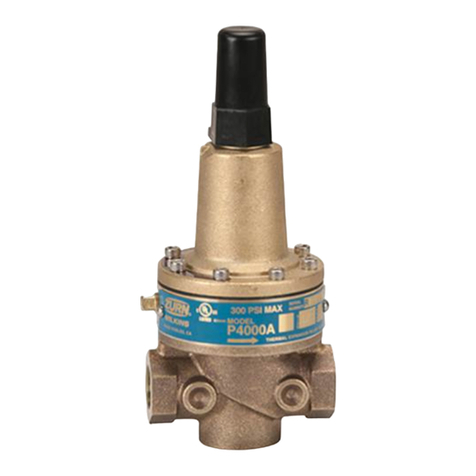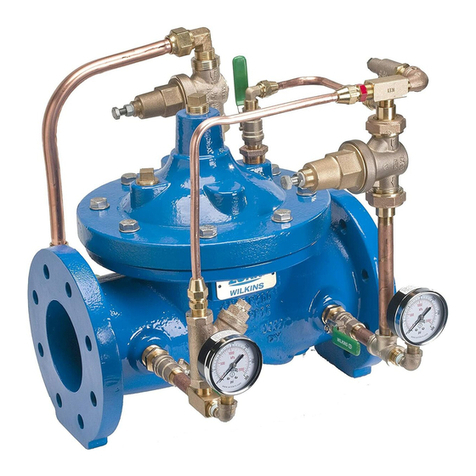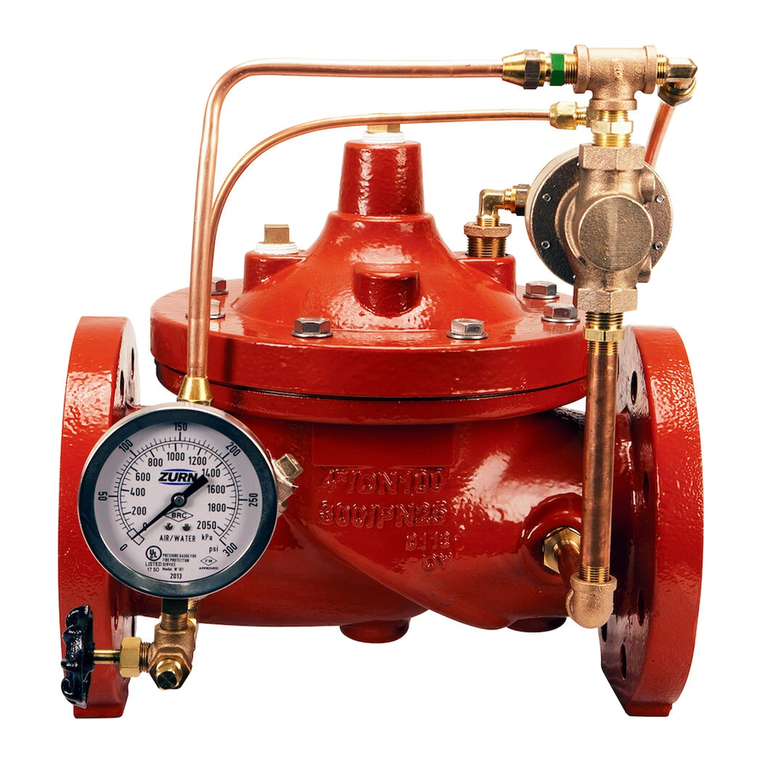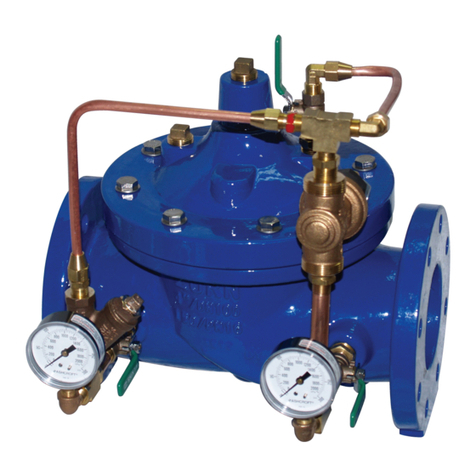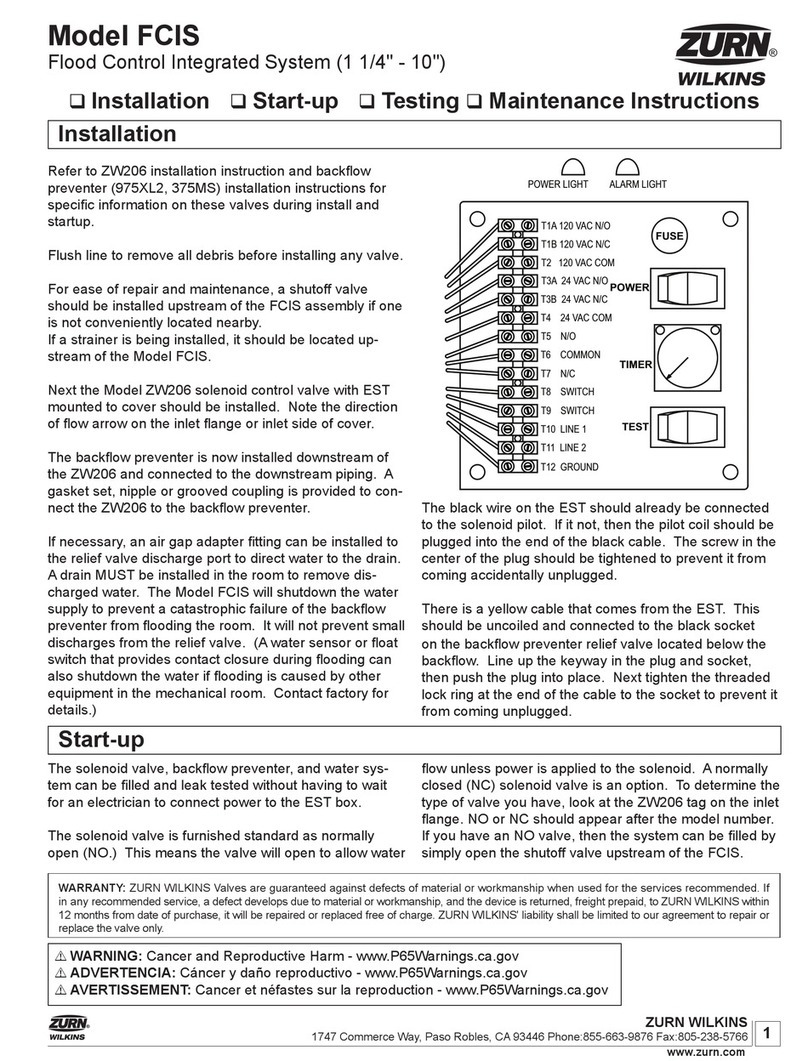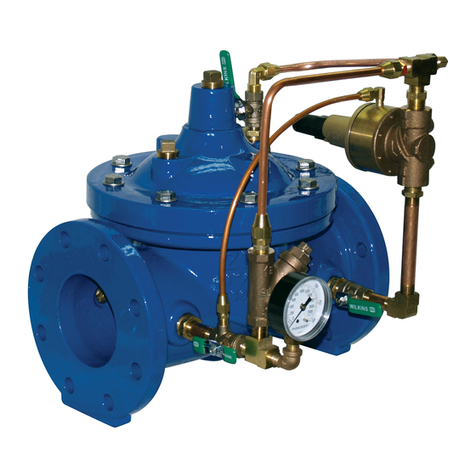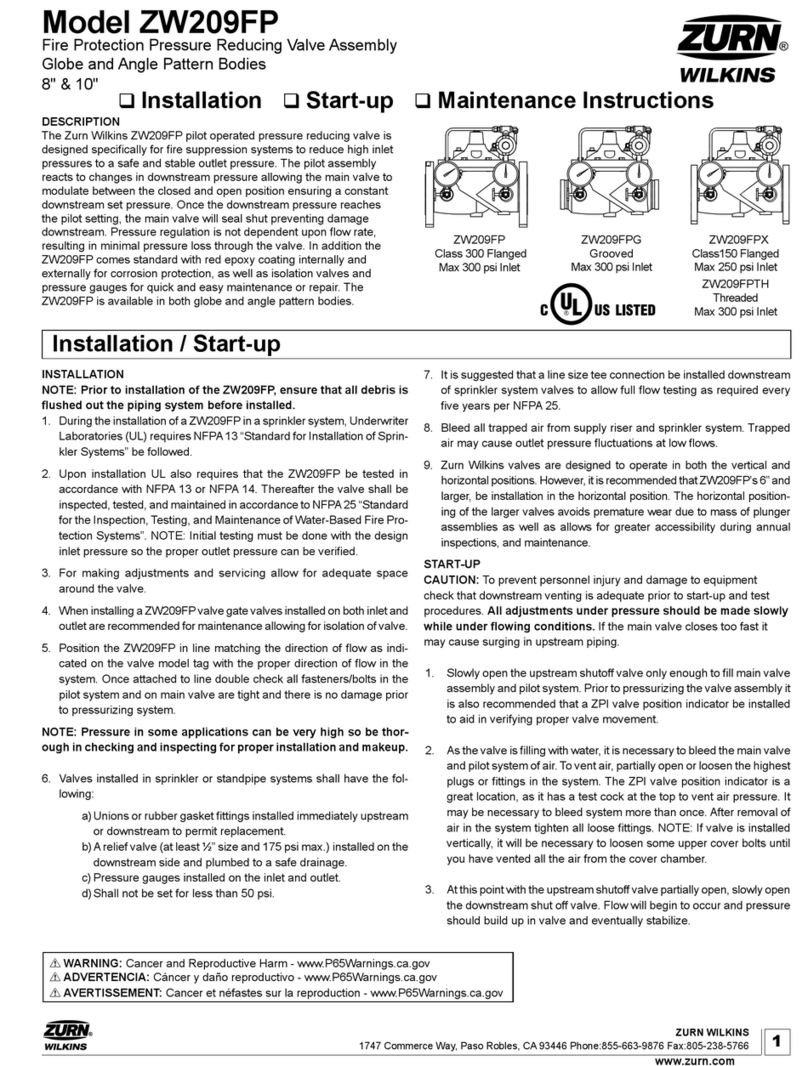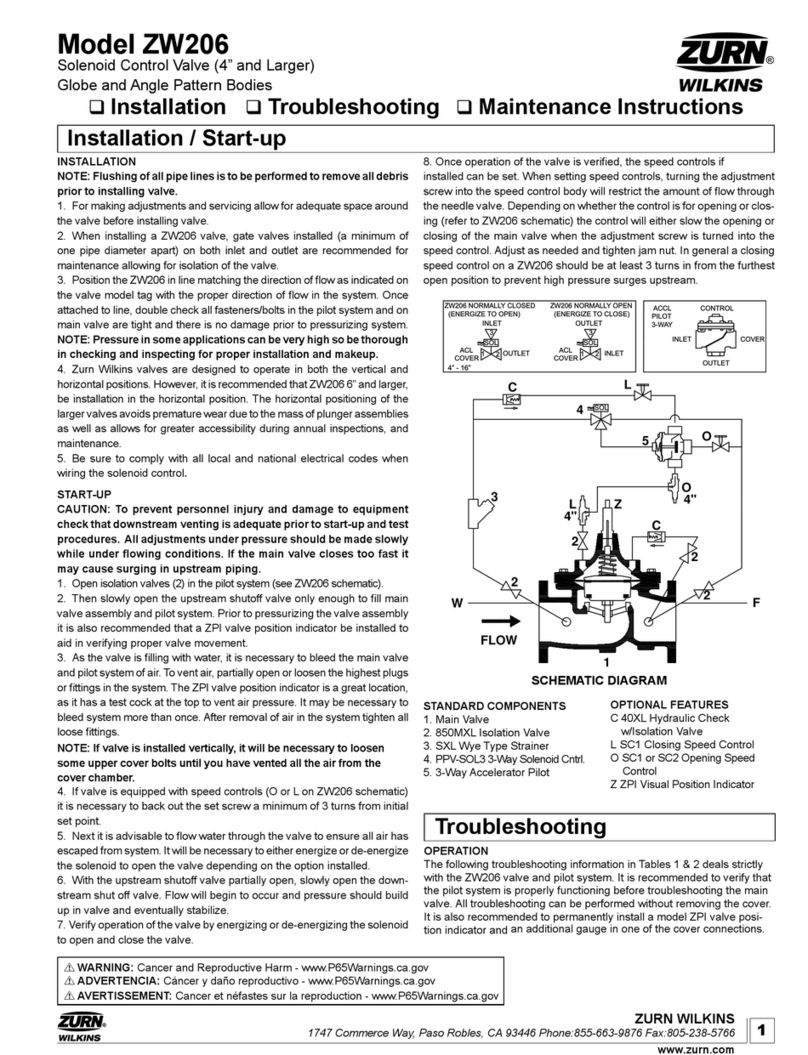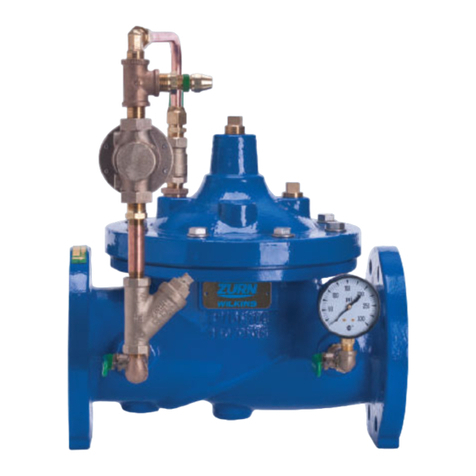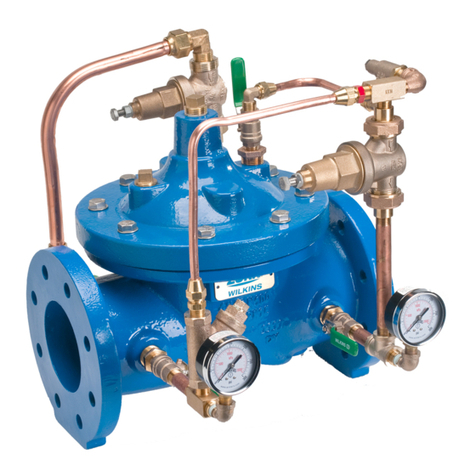
6.Forsmallervalves(6”andbelow)diaphragmcheckscanbe
performed by hand with the use of a valve stem tool. The valve
stemtoolcanbemadeusingTable4tocreatea“T”barhandle
withtheappropriatethreadsontheoppositeendofthe“T”handle.
TABLE 4. VALVE STEM THREAD SIZE
7. To perform the diaphragm check using the vale stem tool,
rstremoveallpressureinthesystemandventthecover.
Then remove the center plug on the cover and insert tool into
the top of the stem threads. Once the tool is inserted, the
valve can be lifted up and the valve movement can be mea-
sured by creating marks on the tool in the opened and closed
positions. The distance between marks is the valve stem
travel.Replaceorrepairanypartsasnecessary.
SEAL CHECK
1. To check the seal of the valve disc, an additional pressure
gauge will be needed downstream of main valve.
2.Withthevalveowing,slowly,closepilotoutletballvalves
to apply pressure to cover and allow to close.
3. Open downstream source and monitor the pressure on the
inlet and installed outlet gauge, for one min. The pressure on
theoutletsideshouldremainzero.Ifthepressurematchesinlet
pressure or increases, the main valve is leaking or the outlet
ball valve on the pilot system is allowing pressure to creep by.
Either way it is recommended that the valve be disassembled
andinspected(referto“Disassembly”section).
Troubleshooting
Maintenance Instructions
PREVENTATIVE MAINTENANCE
The Zurn Wilkins ZW200 models require minimal maintenance.
However, it is highly recommended to schedule annual inspec-
tions and to have a repair kit on hand before work begins.
DISASSEMBLY
Warning: Because of the ability to perform inspections and
maintenance without removal from the system, it is very
important that all shut off valves be closed and all pressure
relieved in the valve before beginning disassembly. Failure
to do so can result in personnel injury or equipment damage.
1. Verify that all pressure sources are closed up and down-
stream of valve.
2.Removepressureinpilotsystembylooseningthetubet-
tings to the valve body and cover. When all pressure has been
vented, continue to disassemble the pilot control valve and
cover tubing. NOTE: Taking a picture before tear down can help
with re-assembly of pilot system.
3. Next remove the cover by loosening and removing the
coverbolts.Ifthecoverdoesnotcomeoffeasilyitmaybenec-
essary to loosen the cover using a brass chisel and rubber mal-
let.Applythechiselunderthecoverpointingupwardawayfrom
valve body and tap bottom of cover with the chisel and mallet to
loosen the cover. Once the cover is loose, pull cover straight up
to avoid damaging the stem and stem bearing in the cover. On
largervalves8”andup,eyeboltsandahoistarerecommended
due to the weight of these larger covers.
4.Withthecoverremovedthediaphragmassemblycanbe
removed. To avoid damaging the seat bushing, grab the stem
andliftstraightup.Forlargervalves8”andupitisrecommended
that an eye bolt with the proper stem threads be used with a
hoisttolifttheassemblyoutofthevalve(seeTable4forap-
propriatestemthreads).
5.Nextitisrecommendedthatthediaphragmassemblybe
placed in a vise with the bottom hex nut secured. Once secured
remove the spring and stem nut. While removing the nut inspect
the stem threads. Clean stem with a wire brush if mineral de-
posits or corrosion are present.
6.Afterinspectingthestemandremovingthenutthediaphragm
assemblycanbedismantled.Ifthevalvehasnotbeenserviced
in a while it is possible that the assembly will require the use of a
rubbermalletorprybarstodismantletheassembly.Ifthisisthe
case gently tap or pry the components until the components are
free to move. When disassembling be sure to clean, inspect, and
saveallcomponents.Replaceanydamagedcomponentsas
necessary.
7. The last component to inspect is the seat which is in the body
of the main valve. During inspection of the seat, clean and polish
asnecessarywithnegritwet/drysandpaper(400gritorhigher).
Typically, if after cleaning there is no visual damage or excessive
weartheseatshouldnotrequireremoval.Ifdamageispresent
or the seat is excessively worn the seat should be replaced.
8.Toremovetheseat,onvalves6”andsmallertheseatis
threaded into the body and will require a seat removal tool. Care
should be taken when removing the seat to avoid damaging.
On8”andlargervalves,theseatisheldinplacewithathead
hex screws. For larger valves a seat puller may be required to
remove the seat from the body.
INSPECTION OF COMPONENTS
Cleaningofcomponentsisrequiredforproperinspection.Lime
deposits are common in systems that use water. To remove
deposits,negritwet/drysandpaper(400gritorhigher)canbe
used.Ifdepositscannotberemoved,offtheshelflimedeposit
remover can be used. Prepare a solution following the lime
depositremoverinstructionsandsoakcomponents(excluding
rubbercomponents)untillimedepositsareremoved.
CAUTION: When handling chemicals (acids) be sure to use
proper safety equipment (gloves and eye protection) and
practices. After soaking components, be sure to thorough-
ly rinse all components before handling and re-assembling
valve.
Once all valve components have been cleaned, inspect each
componentlookingfordamage,abnormalwear&corrosion,
andreplaceallcomponentsthatlookquestionable.Replaceall
rubber components including the diaphragm, o-rings and disc
eachtimethevaleisservicedorinspected(rubbercomponents
are standard in ZW200 repair kits.
4ZURN WILKINS
1747 Commerce Way, Paso Robles, CA 93446 Phone:855-663-9876 Fax:805-238-5766
www.zurn.com
VALVESIZE(in) THREADSIZEUNFINTERNAL
1-1/4"-1-1/2" 10-32
2" 10 - 32
2-1/2" 10 - 32
3" 1/4-20
4" 1/4-20
6" 1/4-20
8" 3/8-16
10" 3/8-16
12" 3/8-16
14" 3/8-16
16" 3/8-16
